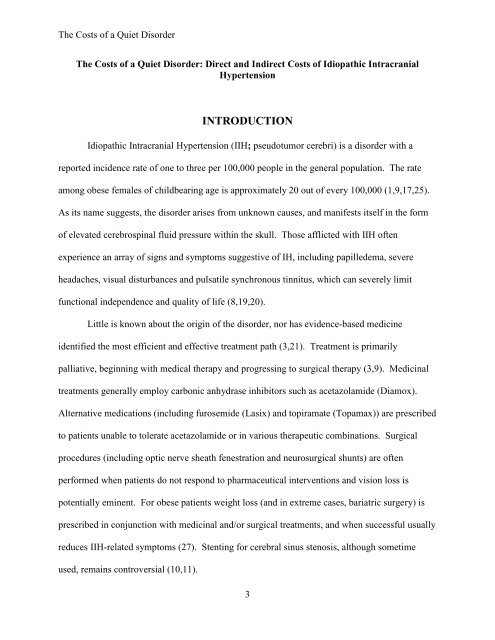Idiopathic Intracranial Hypertension - Washington State University
Idiopathic Intracranial Hypertension - Washington State University
Idiopathic Intracranial Hypertension - Washington State University
- No tags were found...
You also want an ePaper? Increase the reach of your titles
YUMPU automatically turns print PDFs into web optimized ePapers that Google loves.
The Costs of a Quiet DisorderThe Costs of a Quiet Disorder: Direct and Indirect Costs of <strong>Idiopathic</strong> <strong>Intracranial</strong><strong>Hypertension</strong>INTRODUCTION<strong>Idiopathic</strong> <strong>Intracranial</strong> <strong>Hypertension</strong> (IIH; pseudotumor cerebri) is a disorder with areported incidence rate of one to three per 100,000 people in the general population. The rateamong obese females of childbearing age is approximately 20 out of every 100,000 (1,9,17,25).As its name suggests, the disorder arises from unknown causes, and manifests itself in the formof elevated cerebrospinal fluid pressure within the skull. Those afflicted with IIH oftenexperience an array of signs and symptoms suggestive of IH, including papilledema, severeheadaches, visual disturbances and pulsatile synchronous tinnitus, which can severely limitfunctional independence and quality of life (8,19,20).Little is known about the origin of the disorder, nor has evidence-based medicineidentified the most efficient and effective treatment path (3,21). Treatment is primarilypalliative, beginning with medical therapy and progressing to surgical therapy (3,9). Medicinaltreatments generally employ carbonic anhydrase inhibitors such as acetazolamide (Diamox).Alternative medications (including furosemide (Lasix) and topiramate (Topamax)) are prescribedto patients unable to tolerate acetazolamide or in various therapeutic combinations. Surgicalprocedures (including optic nerve sheath fenestration and neurosurgical shunts) are oftenperformed when patients do not respond to pharmaceutical interventions and vision loss ispotentially eminent. For obese patients weight loss (and in extreme cases, bariatric surgery) isprescribed in conjunction with medicinal and/or surgical treatments, and when successful usuallyreduces IIH-related symptoms (27). Stenting for cerebral sinus stenosis, although sometimeused, remains controversial (10,11).3
















